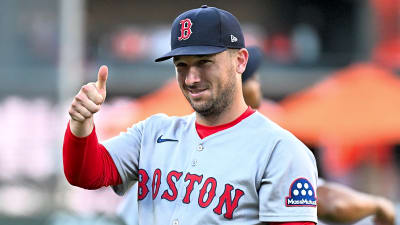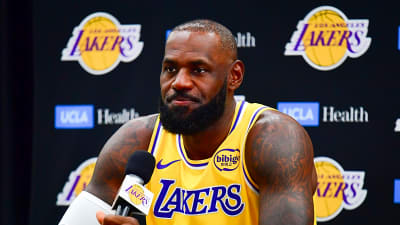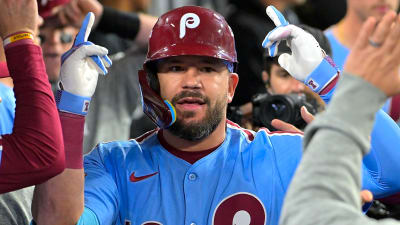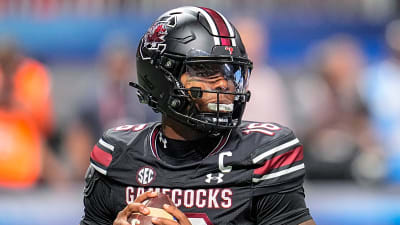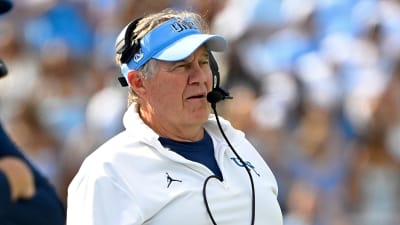- Home
- Quizzes
- My Quiz Activity
- Newsletters
- MY FAVORITES
- Add Sports/Teams
- SPORTS
-
NFL
- NFL Home
- Arizona Cardinals
- Atlanta Falcons
- Baltimore Ravens
- Buffalo Bills
- Carolina Panthers
- Chicago Bears
- Cincinnati Bengals
- Cleveland Browns
- Dallas Cowboys
- Denver Broncos
- Detroit Lions
- Green Bay Packers
- Houston Texans
- Indianapolis Colts
- Jacksonville Jaguars
- Kansas City Chiefs
- Las Vegas Raiders
- Los Angeles Chargers
- Los Angeles Rams
- Miami Dolphins
- Minnesota Vikings
- New England Patriots
- New Orleans Saints
- New York Jets
- New York Giants
- Philadelphia Eagles
- Pittsburgh Steelers
- San Francisco 49ers
- Seattle Seahawks
- Tampa Bay Buccaneers
- Tennessee Titans
- Washington Commanders
-
MLB
- MLB Home
- Athletics
- Arizona Diamondbacks
- Atlanta Braves
- Baltimore Orioles
- Boston Red Sox
- Chicago White Sox
- Chicago Cubs
- Cincinnati Reds
- Cleveland Guardians
- Colorado Rockies
- Detroit Tigers
- Houston Astros
- Kansas City Royals
- Los Angeles Angels
- Los Angeles Dodgers
- Miami Marlins
- Milwaukee Brewers
- Minnesota Twins
- New York Yankees
- New York Mets
- Philadelphia Phillies
- Pittsburgh Pirates
- San Diego Padres
- San Francisco Giants
- Seattle Mariners
- St. Louis Cardinals
- Tampa Bay Rays
- Texas Rangers
- Toronto Blue Jays
- Washington Nationals
-
NBA
- NBA Home
- Atlanta Hawks
- Boston Celtics
- Brooklyn Nets
- Charlotte Hornets
- Chicago Bulls
- Cleveland Cavaliers
- Dallas Mavericks
- Denver Nuggets
- Detroit Pistons
- Golden State Warriors
- Houston Rockets
- Indiana Pacers
- Los Angeles Clippers
- Los Angeles Lakers
- Memphis Grizzlies
- Miami Heat
- Milwaukee Bucks
- Minnesota Timberwolves
- New Orleans Pelicans
- New York Knicks
- Oklahoma City Thunder
- Orlando Magic
- Philadelphia 76ers
- Phoenix Suns
- Portland Trail Blazers
- Sacramento Kings
- San Antonio Spurs
- Toronto Raptors
- Utah Jazz
- Washington Wizards
-
NHL
- NHL Home
- Anaheim Ducks
- Boston Bruins
- Buffalo Sabres
- Calgary Flames
- Carolina Hurricanes
- Chicago Blackhawks
- Colorado Avalanche
- Columbus Blue Jackets
- Dallas Stars
- Detroit Red Wings
- Edmonton Oilers
- Florida Panthers
- Los Angeles Kings
- Minnesota Wild
- Montreal Canadiens
- Nashville Predators
- New Jersey Devils
- New York Islanders
- New York Rangers
- Ottawa Senators
- Philadelphia Flyers
- Pittsburgh Penguins
- San Jose Sharks
- Seattle Kraken
- St. Louis Blues
- Tampa Bay Lightning
- Toronto Maple Leafs
- Utah Mammoth
- Vancouver Canucks
- Vegas Golden Knights
- Washington Capitals
- Winnipeg Jets
- NCAAF
- NCAAM
- Olympics
- Boxing
- Entertainment
- Lifestyle
- Golf
- MMA
- Soccer
- Tennis
- Wrestling
- Sports Betting
- More Sports
- RESOURCES
- My Account
- YB on Facebook
- YB on Twitter
- YB on Flipboard
- Contact Us
- Privacy Policy
- Terms of Service
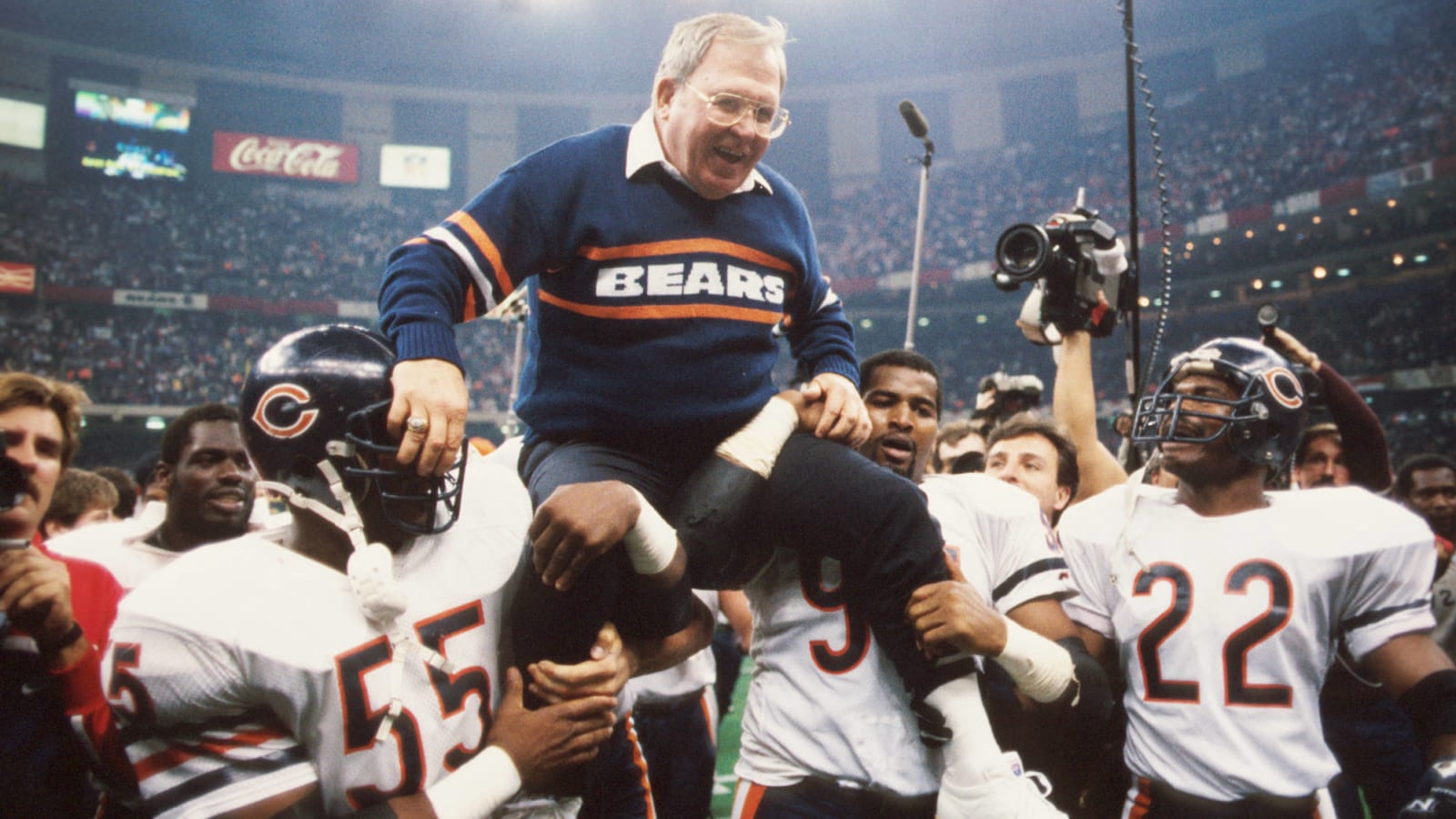
Which NFL teams have allowed the fewest points in the 16-game era?
Many Super Bowl celebrations have occurred after the assembly of a dominant defense. Even when elite defenses did not produce a title, they have often defined an era for a franchise. Here are the best scoring defenses of the past 42 years. For consistency purposes, we're limiting this to the 16-game season era (1978-present).
Bonus: 1977 Atlanta Falcons
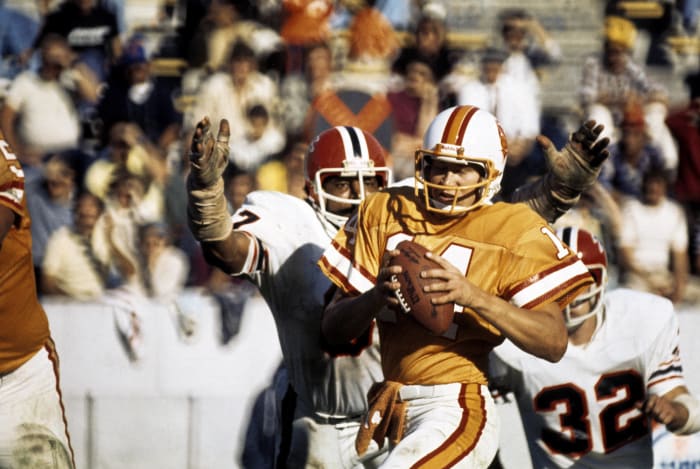
But first, due respect for a 14-game superpower.
Atlanta's "Grits Blitz" defense held opponents to 9.2 points per game in 1977. That tops any team's effort in the past 60 years. Operating before the 1978 offense-favoring rule changes aided Atlanta, but these Falcons are a forgotten force. They snared 26 interceptions and allowed just nine touchdown passes. Cornerback Rolland Lawrence picked off seven throws. The Falcons threw relentless pressure at opposing QBs, recovering 41 fumbles, providing a precursor to the Bears' 46 defense. They are forgotten because this offensively limited team only produced a 7-7 record. A fascinating NFL footnote nonetheless.
T-24. 1980 Philadelphia Eagles
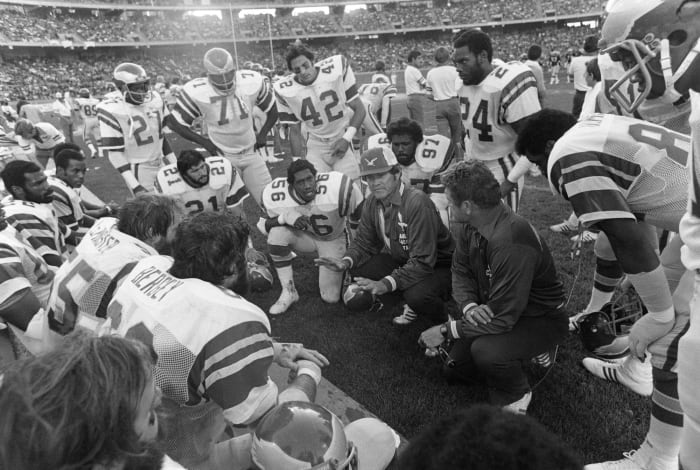
The early-'80s Eagles possessed stellar defenses; this one elevated the franchise to its first Super Bowl. The Eagles relied on their top-ranked defense (13.9 points allowed per game) to reach Super Bowl XV. Pro Bowl linebacker Bill Bergey, in his final season, joined Hall of Fame defensive end Claude Humphrey -- a Falcons trade get who had 12.5 sacks in 1980 -- and All-Pro nose tackle Charlie Johnson in leading this 3-4 defense. (Herm Edwards was also a starting corner.) Philly (12-4) allowed seven or fewer points six times and beat both its NFC playoff opponents (Minnesota and Dallas) by at least two scores.
T-24. 2008 Pittsburgh Steelers

Featuring future Hall of Famer Troy Polamalu and Defensive Player of the Year James Harrison, these Steelers led the league in both yards and points (13.9 per game) allowed. This defense carried a 20th-ranked offense to Super Bowl XLIII, and Harrison's 100-yard INT return in the win over the Cardinals remains an all-time NFL sequence . Polamalu's signature play may have also occurred in 2008; the safety's cross-field pick-6 iced the Ravens in a physical AFC championship game. Outside linebackers Harrison and LaMarr Woodley combined for 27.5 sacks for likely the franchise's best post-Steel Curtain defense.
23. 1981 Philadelphia Eagles

For a second straight year, the Eagles led the NFL in defense. Defensive coordinator Marion Campbell's unit yielded 13.8 points per game and helped the team to a 6-0 start. Nose tackle in Philly's 3-4 base, Charlie Johnson made his second straight All-Pro team. Linebackers Jerry Robinson and Frank LeMaster, and cornerback Roynell Young, joined Johnson as Pro Bowlers. The Eagles (10-6 in 1981) allowed 27 points in a wild-card loss to the Giants, however, and dropped to 19th in defense in 1982's strike-shortened season. Philadelphia did not resurface as a top-tier defense until Reggie White and Buddy Ryan joined forces.
T-21. 1996 Carolina Panthers

The 1996 season brought two historic get-rich-quick stories. Second-year franchises Carolina and Jacksonville voyaged to the conference championship round. The Panthers rode their No. 2-ranked defense, which gave up 13.6 PPG. GM Bill Polian's free-agency blueprint brought 1996 All-Pros Sam Mills and Kevin Greene (14.5 sacks) to Carolina, with fellow veteran adds in linebacker Lamar Lathon (13.5 sacks) and cornerback Eric Davis going to the Pro Bowl. Dom Capers and Vic Fangio's defense keyed a 12-4 march. The Panthers swept the 49ers and beat the defending champion Cowboys in Round 2.
T-21. 1999 Jacksonville Jaguars

The best team in the Jaguars' 25-year history, the '99 squad went 14-2 and led the NFL in permitting just 13.6 PPG. Jacksonville won 11 straight games to secure home-field advantage in the AFC, doing so with key contributions from Pro Bowlers Kevin Hardy, Tony Brackens and Carnell Lake. A hybrid linebacker-pass rusher, Hardy managed 98 tackles and 10.5 sacks -- a combination only four players have hit in the past 20 years. The Jags forced four Dan Marino turnovers in a 62-7 divisional-round demolition, Marino's final game, but their 0-3 record against the Titans that year cost the team a Super Bowl berth.
20. 1988 Chicago Bears

Jim McMahon's injuries led to the Bears' offense going south by 1988, but Chicago still had elite defensive capabilities. Middle linebacker Mike Singletary claimed his second Defensive Player of the Year honor and had the Bears No. 1 in defense for a third time in four years. Chicago (12-4) allowed 13.4 PPG, dragging its No. 18 offense to the NFC's No. 1 seed. During a five-game early-season win streak, Chicago held each opponent to single-digit points. Steve McMichael and Hall of Famers Richard Dent and Dan Hampton combined for 31.5 sacks. The 49ers, however, routed the Bears 28-3 in the NFC title game.
19. 2001 Pittsburgh Steelers

Holding foes to 13.3 PPG, the No. 3 defense in 2001 checks in here. This is a forgotten Steeler defense, likely because it could not come out on top against Tom Brady and Drew Bledsoe in that year's AFC championship game. But this unit housed two Pro Bowl linebackers -- All-Pro Jason Gildon and Defensive Rookie of the Year Kendrell Bell -- and saw five players post at least eight sacks, led by Gildon's 12. Bell made 23 tackles for loss -- the most by a 21st-century rookie -- and cornerback Chad Scott posted 204 interception return yards and two pick-6s. Just one of the Pats' three TDs in that title game came on offense.
T-17. 1991 New Orleans Saints

An all-time NFL position group , the Saints' Dome Patrol linebacking quartet spearheaded the franchise's first NFC West title. The second level of New Orleans' 3-4 look -- Rickey Jackson, Pat Swilling, Sam Mills and Vaughan Johnson -- helped the team unseat the 49ers in the NFC West, doing so while allowing an NFL-least 13.2 PPG. The Vic Fangio-coached LBs had Swilling win Defensive Player of the Year with a 17-sack season, and Mills -- a 5-foot-9 inside 'backer -- joined him in Hawaii. Safety Gene Atkins, father of Bengals D-tackle Geno Atkins, also notched five INTs and 198 return yards. Jim Mora's team finished 11-5.
T-17. 1990 New York Giants

The second Giants Super Bowl champion did not boast as much defensive talent as 1986's, but this unit was statistically superior. The '90 Giants led the league by allowing 13.2 PPG. During a 10-0 Giants start, the Bill Parcells- and Bill Belichick-guided defense limited five teams to seven or fewer points. Lawrence Taylor was in the latter part of his prime but still notched 10.5 sacks and joined All-Pro inside 'backer Pepper Johnson in the Pro Bowl. These Giants ended Joe Montana's 49ers run by knocking him out of the NFC title game -- a historic 15-13 defensive battle -- and topped the K-Gun Bills soon after.
16. 1996 Green Bay Packers

Reggie White's fourth Green Bay season produced the first Packers championship in 29 years. Green Bay led the NFL in offense and defense (13.1 points allowed per game) in 1996 and cruised to the Super Bowl XXXI title, with its left defensive end sacking Drew Bledsoe three times in the second half. The Packers held nine regular-season opponents to 10 or fewer points. Although no Packer posted double-digit sacks, safeties Leroy Butler, Eugene Robinson and cornerback Doug Evans each picked off five-plus passes for DC Fritz Shurmur's unit.
T-14. 1978 Dallas Cowboys

One of the latter Doomsday editions, this Cowboys defense outproduced its 1977 Super Bowl consolidation -- despite the offense-favored rule changes of '78 -- by holding teams to 13.0 points per game. These Cowboys beat just one playoff team during the regular season, but the defending champions shut out the Rams 28-0 in the NFC title game. Safeties Cliff Harris and Charlie Waters, along with linebacker Hollywood Henderson and Super Bowl XII co-MVP Harvey Martin, a D-lineman, received Pro Bowl invitations. But the Steelers dropped 35 points on this defense in Super Bowl XIII.
T-14. 2001 Philadelphia Eagles

The first of the early-aughts Eagles' four consecutive NFC championship game cameos featured the league's No. 2 defense (13.0 PPG) backing Donovan McNabb and Co. Seven future head coaches worked on this Andy Reid staff, with defensive coordinator Jim Johnson's group including linebackers coach Ron Rivera and both Steve Spagnuolo and Leslie Frazier helming the DBs. Hall of Famer Brian Dawkins joined Pro Bowler Troy Vincent in the secondary, which intercepted Brad Johnson four times in the wild-card round and held the Bears to under 100 passing yards in a road Round 2 win a week later.
T-12. 1994 Cleveland Browns

Bill Belichick left the Giants for the Browns' head-coaching job in 1991. The coaching icon was 1-for-5 in postseason berths in Cleveland, but his '94 team went 11-5 and allowed a league-low 12.8 PPG. Ex-Belichick Giants linebackers Carl Banks and Pepper Johnson started, as did 2001 Patriot defensive end starter Anthony Pleasant. Not unlike recent Patriots defenses, this unit did not have a superstar -- though All-Pro safety Eric Turner (nine INTs, 105 tackles) was close at the time -- but it helped the Browns win their only playoff game in the past 29 years. The then-Ravens fired Belichick in 1996.
T-12. 1993 New York Giants

Lawrence Taylor's final season produced one of the more underappreciated defenses in modern NFL history. A Week 18 overtime loss to the Cowboys cost the Giants home-field advantage, but Mike Nolan's defense led the league in ceding 12.8 PPG. Using a mix of Super Bowl XXV holdovers and young players who'd become members of New York's Super Bowl XXXV squad (Michael Strahan, linebacker Jessie Armstead, defensive tackle Keith Hamilton), these Giants provided a last stand of sorts for a great era. But no Pro Bowlers resided on this defense. And the 49ers ended said era with a 44-3 Round 2 demolition.
11. 2001 Chicago Bears

During one of the most random 13-win seasons in NFL history, these Bears won a stiff competition for 2001's top defense in yielding 12.7 PPG. Chicago's Jim Miller-quarterbacked offense had no Pro Bowlers; its defense deployed three All-Pros in Brian Urlacher, touchdown-scoring safety Mike Brown and D-tackle mercenary Ted Washington. Roosevelt Colvin also notched 10 sacks from his 4-3 outside linebacker post. Brown delivered back-to-back pick-6 walk-offs in OT wins, and Chicago scored five defensive TDs. The Bears, though, gave up 33 points to the Eagles in Round 2 and did not return to the playoffs until 2005.
T-8. 2006 Baltimore Ravens

In a stacked AFC season, the Ravens earned a higher seed than both the Patriots and Super Bowl champion Colts. Rex Ryan's defense allowed 12.6 PPG and held the defending Super Bowl champion Steelers to seven points in the rivals' two games. Six Raven defenders -- Ray Lewis, Ed Reed, Terrell Suggs, Bart Scott, Adalius Thomas and Chris McAllister -- made the Pro Bowl, and Trevor Pryce added a team-best 13 sacks. This group was nearly as talented as the famed 2000 unit, and it limited the Colts to five field goals in the teams' playoff meeting. But Indianapolis won 15-6.
T-8. 2005 Chicago Bears

A reloaded Bears team returned to the playoffs with an even less balanced roster. This marks one of the league's most impressive defensive efforts, with Lovie Smith's team going 11-5 despite fourth-round rookie Kyle Orton piloting the NFL's No. 26 offense. The Bears' 12.6 points allowed per game was nearly three better than second place that year; Chicago held nine nine teams to 10 or fewer points. An apex Urlacher season produced Defensive Player of the Year acclaim, and Mike Brown, Charles Tillman, Lance Briggs and defensive tackle Tommie Harris were Pro Bowlers. Steve Smith torched the Bears in a Round 2 upset, however.
T-8. 1992 New Orleans Saints
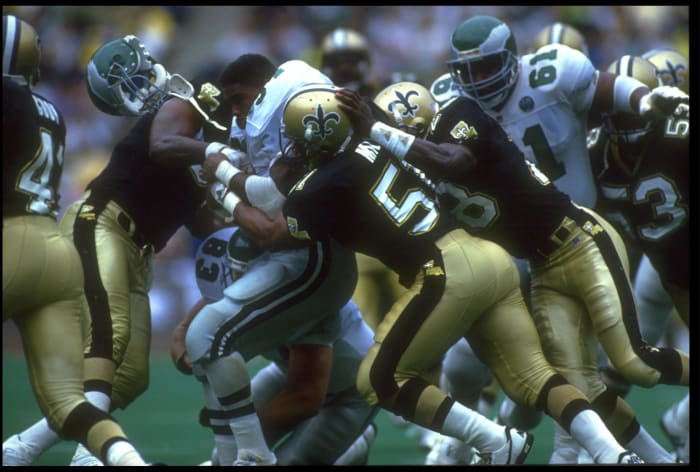
Before the adjusted Pro Bowl schedule, alternates were not as frequently summoned. That makes the 1992 Saints' feat more impressive. All four of its Dome Patrol linebackers made that year's Pro Bowl, occupying four of the NFC's eight LB slots. D-coordinator Steve Sidwell's group held opponents to a league-low 12.6 PPG. In addition to the linebackers' excellence, defensive end Wayne Martin recorded 15.5 sacks, cornerback Toi Cook snared six INTs and D-tackle Robert Goff returned two fumbles for TDs. The Eagles scored 36 points in a wild-card comeback, however, effectively ending a promising Saints era.
T-6. 1985 Chicago Bears

Statistically, the most revered defense in NFL history checks in here. But the 12.4 points per game Buddy Ryan's 46 defense allowed pales in comparison to the panic its relentless pressure caused. The Bears recorded a league-leading 64 sacks, had six defensive Pro Bowlers -- with Steve McMichael, Richard Dent and Defensive Player of the Year Mike Singletary earning All-Pro acclaim -- and allowed just 10 playoff points in probably the best defensive run in modern postseason history. After shutting out the Giants and Rams, the Bears held the Patriots to seven rushing yards and led 44-3 at one point in Super Bowl XX.
T-6. 1978 Denver Broncos

Factoring in the 1978 rule changes, this defense probably outworked the renowned 1977 Orange Crush group that led Denver to its first Super Bowl. The '78 team allowed 12.4 PPG (behind the '77 team's 10.6) but was freakishly consistent. Only three teams scored 20 points on Joe Collier's 3-4 defense. Tom Jackson and Hall of Fame candidate Randy Gradishar represented the linebacking corps in the Pro Bowl, with shutdown corner Louis Wright and polarizing D-lineman Lyle Alzado joining them. The Steelers, though, avenged their 1977 Denver elimination in the playoffs with a 33-10 win.
5. 2002 Tampa Bay Buccaneers

Stacked on all three levels, the Bucs' Super Bowl champion defense helped the team overcome recent playoff shortcomings. Monte Kiffin's group allowed just 12.3 PPG. The Derrick Brooks- and Warren Sapp-led defense limited Michael Vick's Falcons to 16 combined points and held NFC playoff opposition to 16 -- including a 27-10 win over the Eagles, who eliminated the previous two Buccaneer editions. Standout D-end Simeon Rice (15.5 sacks) joined Brooks and Sapp as an All-Pro. The Bucs intercepted five Rich Gannon passes in Super Bowl XXXVII. Corner Dwight Smith somehow missed MVP acclaim after a two-pick-6 night.
4. 1978 Pittsburgh Steelers

This Mt. Rushmore NFL squad did not even have the best Steel Curtain version; that'd be 1976's. But this Steelers defense still led the league, and Pittsburgh's offense caught up. Despite the illegal-contact provision Mel Blount Rule designed to restrict defenses, Pittsburgh allowed three touchdowns in a game only twice in 1978. Defensive coordinator Bud Carson left after 1977, but George Perles' unit allowed 12.2 PPG and sent six players to the Pro Bowl. En route to a Super Bowl XIII shootout win over the Cowboys, the Steelers outscored the Broncos and Oilers 67-15 in the AFC playoffs.
3. 2000 Tennessee Titans

The AFC Central clash in the 2000 divisional round does not receive sufficient attention; it pitted two of the best three scoring defenses of the past 40 years against each other. The Titans earned the AFC's top seed behind 2000's second-ranked defense (11.9 PPG). Gregg Williams' group bettered the Ravens against the pass. Cornerback Samari Rolle snared seven INTs in an All-Pro slate; Houston Oiler holdover Blaine Bishop was a Pro Bowler. Jevon Kearse again recorded double-digit sacks. This defense only allowed 10 points against the Ravens, but Baltimore's two non-offensive TDs in a 24-10 Round 2 clash were the difference.
2. 1986 Chicago Bears
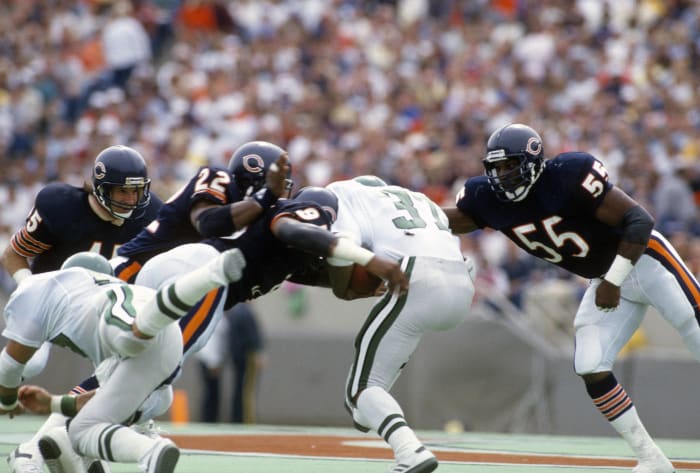
Were it not for a preposterously dirty hit in a Packers-Bears 1986 game, this Chicago team may be remembered much differently. The Bears followed up their 15-1 season with a 14-2 record, and its defense -- without departed coordinator Buddy Ryan -- outproduced its legendary predecessor. The Vince Tobin-coordinated corps allowed 11.7 PPG, recording 62 sacks and 31 INTs. DBs Mike Richardson and Dave Duerson, and then-all-world outside linebacker Wilbur Marshall, combined for 18. The same defensive cast, however, couldn't overcome Jim McMahon's season-ending injury, losing to Washington in its playoff opener.
1. 2000 Baltimore Ravens
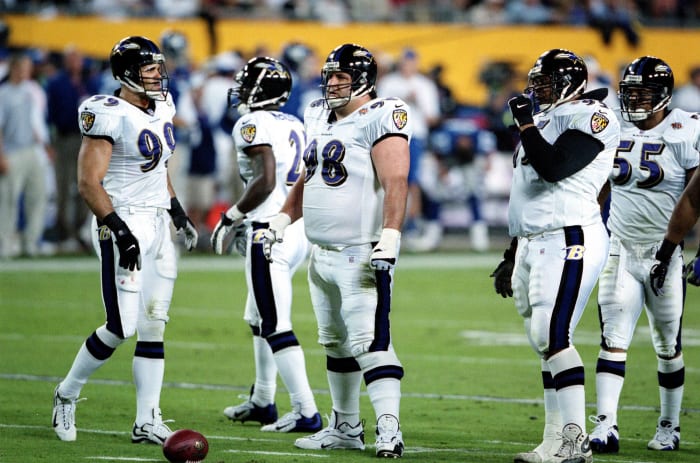
These Ravens won a Super Bowl despite going five straight games without scoring an offensive touchdown. They allowed one offensive TD in 16 playoff quarters; the Giants did not score an offensive point in Super Bowl XXXV. Overseen by DC Marvin Lewis, Baltimore's defense may be the best ever. The Ravens (12-4) ceded 10.3 points per game and in 20 games allowed only five teams to surpass 10 points. Ray Lewis earned Defensive Player of the Year acclaim and Super Bowl MVP honors, and his Peter Boulware-Jamie Sharper linebacker mates joined Rod Woodson and a host of locked-in role players to produce all-time defensive dominance.
Sam Robinson is a sportswriter from Kansas City, Missouri. He primarily covers the NFL for Yardbarker. Moving from wildly injury-prone sprinter in the aughts to reporter in the 2010s, Sam set up camp in three time zones covering everything from high school water polo to Division II national championship games
More must-reads:
- Potential Caleb Williams-Troy Aikman beef won't be the first of its kind
- Anonymous Eagles player explains major concern to NFL insider
- The '2024 TD catch leaders by team' quiz
Breaking News
Trending News
Customize Your Newsletter
 +
+
Get the latest news and rumors, customized to your favorite sports and teams. Emailed daily. Always free!
PRIVACY POLICY EDITORIAL POLICY CONTACT US
ABOUT YARDBARKER TERMS OF SERVICE
Use of this website (including any and all parts and
components) constitutes your acceptance of these
Terms of Service and Privacy Policy.
This site is for entertainment purposes only.
There is no gambling offered on this site.
Gambling Problem? Call 1-800-Gambler.

